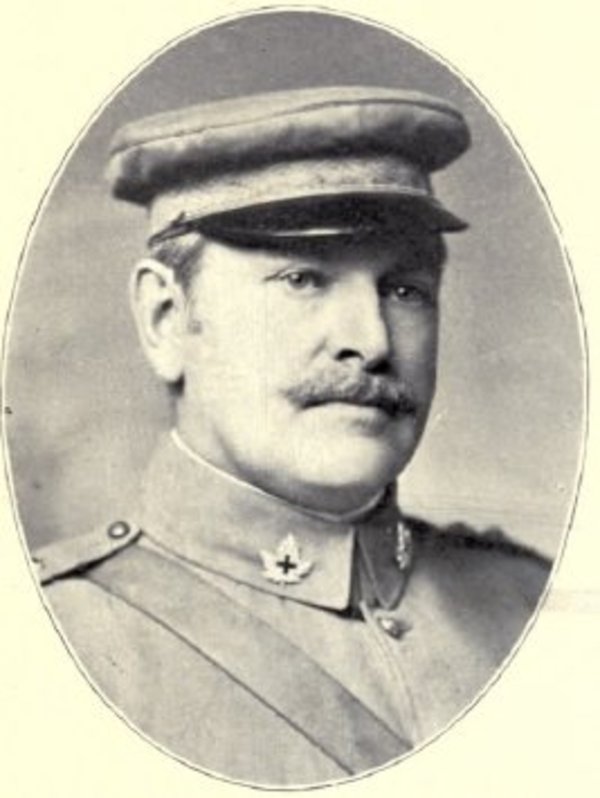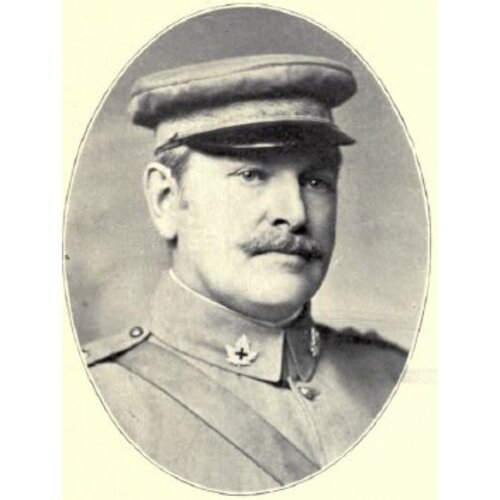
Source: Courtesy of Wikimedia Commons
RYERSON, GEORGE ANSEL STERLING, physician, teacher, militia and army officer, politician, author, and businessman; b. 21 Jan. 1855 in Toronto, only son of George Ryerson* and Isabella Dorcas Sterling; m. first 14 Nov. 1882 Mary Amelia Crowther (d. 1915) in Toronto, and they had four sons and one daughter; m. secondly 8 June 1916 Elizabeth Van Hook Mann, née Thomas (d. 1924) in Buffalo, N.Y.; they had no children; d. 20 May 1925 in Toronto.
George Sterling Ryerson was born into one of Upper Canada’s most renowned families and emerged as an archetypal Toronto Tory. His grandfather Joseph Ryerson had been a distinguished loyalist, and his father, George, brother of the more famous Egerton*, was a notable clergyman who had left the Methodist Episcopal Church in Canada for the millennialist Catholic Apostolic Church, of which he served as head in North America from 1837 to 1872.
George Jr displayed his independence as well as his conservative instincts by opting for membership in the Church of England. He was, however, grateful to his parents for an education that was extraordinary by the standards of the day. After being tutored by William Tassie* at the grammar school in Galt (Cambridge), Ryerson entered Trinity Medical School in Toronto, where he obtained an mb in 1875 (md 1876). He then undertook further academic work in Edinburgh, Paris, London, Vienna, and Heidelberg, Germany.
Ryerson returned to Toronto in 1880 to begin his practice and soon established himself as a leading oculist. That year he was appointed professor of eye, ear, and throat diseases at Trinity Medical School, launching a teaching career which would continue until 1918. Also in 1880 he became surgeon at the Andrew Mercer Eye and Ear Infirmary in the Toronto General Hospital. Ryerson was responsible for a number of innovations in Canadian medicine such as a recognition of the perils of colour blindness. Nevertheless he regretted “that with the fine training I had had in Europe I did not do any original work in my profession.”
One reason for this failure lay in Ryerson’s extensive commitments beyond his practice. As a boy of 15 he had enlisted in the militia during the Fenian troubles of 1870. Once he received his medical training he demonstrated an enduring interest in what he called “military medical affairs.” Thus he became assistant surgeon to the 10th Battalion of Infantry (Royal Grenadiers) and saw action during the North-West rebellion in 1885 [see Darby Bergin*], service that earned him promotion to surgeon the following year. In 1892 he initiated the formation of the Association of Medical Officers of the Canadian Militia, of which he would be elected president in 1908 and 1909. Ryerson was appointed deputy surgeon-general in 1895, and promoted surgeon-major and surgeon-lieutenant-colonel on the same day the following year. On the reserve of officers from 1901, he would be made honorary surgeon-general in 1915 and honorary colonel of the Canadian Army Medical Corps two years later.
In 1892 Ryerson had been appointed an honorary associate of the Order of St John of Jerusalem in England (he would become a knight of grace in 1901); in 1895, under its auspices and with the support of Lieutenant Governor George Airey Kirkpatrick*, he created the St John Ambulance Association in Ontario, an organization he guided as general secretary for 15 years. Ryerson was also instrumental in founding the Canadian Red Cross Society in 1896, became its commissioner to the Canadian forces in South Africa in 1900, and succeeded John Morison Gibson as its president in 1914. During World War I his experience was again put to use: in 1915 he was sent overseas to investigate the needs of hospitals and make a survey of Red Cross work.
Ryerson shared with many prominent Tories in Toronto a fervent devotion to loyalist origins which caused him in 1896 to launch the United Empire Loyalist Association of Ontario, of which he became second president. For him the loyalists of the American revolution had constituted a natural ruling elite, representing, in historian Moses Coit Tyler’s words, a “very considerable portion of the most refined, thoughtful and conscientious people in the colonies.” Ryerson sought to bestow the benefits of similar leadership on the provincial electorate when he successfully upheld the Conservative colours in an 1893 by-election in Toronto. Though he was returned for Toronto East in the general election the following year, in the end his political career proved a “disappointment” to himself and others. His elitist bearing was not appreciated in the legislature where in 1897, for example, Premier Arthur Sturgis Hardy* denounced his “very top lofty ideas” about Ontario society. In 1894 Ryerson had been rejected by his caucus as a potential leader in favour of George Frederick Marter*, and four years later he decided not to contest his seat because of illness. An attempt to revive his political career in 1902 saw him embarrassed by a defeat for the Conservative nomination in Toronto North.
Ryerson’s aristocratic inclinations found a more favourable response in the upper echelons of British society and he described his participation in Queen Victoria’s diamond jubilee in 1897 as the most wonderful day in his life. For him, as for many Canadian Tories, the “perpetual British Empire” was “the mainstay of freedom and civilization throughout the world.” Such sentiments often led him into a racist perspective. For example, he viewed North American natives, South African blacks, and European gypsies as “savage peoples.” He could also be religiously bigoted, as his prominence in the anti-Catholic Protestant Protective Association during the 1890s clearly revealed.
It was only natural that Ryerson gravitated towards the upper class institutions of Canadian society and he solidified his social standing by membership in such exclusive organizations as the masonic order, the Canadian Military Institute, the Toronto Hunt Club, and the Royal Canadian Yacht Club. He insisted that his sons be educated at Upper Canada College. During his later years he became involved in commercial pursuits which further established him as a successful entrepreneur. When he retired from the medical profession in 1920 he was an affluent man and he withdrew to a large estate, Peaceacres, in Niagara-on-the-Lake. There he wrote his memoirs, which were published in 1924, appropriately by Ryerson Press, as Looking backward. Having returned to Toronto to live, he died there the next year of a heart attack following a brief illness.
Ryerson had contributed significantly to the progress of medicine, especially military medicine, in Canada. A paradigm of Toronto Toryism, his political, economic, and social outlook gave him a comfortable life, status, and opportunities for attainments. This outlook was, however, marked by an elitism, racism, and religious intolerance that lessened his moral stature.
George Ansel Sterling Ryerson’s publications include Color blindness in its relation to railway employees and the public (Toronto, [1889?]); The after-math of a revolution . . . (Toronto, 1896); The soldier and the surgeon (Toronto, 1899); Medical and surgical experiences in the South African War . . . (n.p., [1900?]); and Looking backward (Toronto, 1924). An address given by Ryerson in commemoration of the War of 1812 appears in “A century later – Canadian memories of the war . . . ,” in The defended border: Upper Canada and the War of 1812 . . . , ed. Morris Zaslow and W. B. Turner (Toronto, 1964), 321–24.
LAC, MG 27, II, F6 (photocopies). Globe, 15 Nov. 1882, 9 June 1916, 21 May 1925. Can., Dept. of Militia and Defence, Militia list (Ottawa), January 1895, October 1899, January 1901, January 1918. Canada Gazette, January–June 1895: 1750; January–June 1896: 1655–56. Canadian album (Cochrane and Hopkins), 1: 115. Canadian annual rev., 1909, 1911, 1915–16. Canadian men and women of the time (Morgan; 1898 and 1912). CPG, 1897. P. E. P. Dembski, “William Ralph Meredith: leader of the Conservative opposition in Ontario, 1878–1894” (phd thesis, Univ. of Guelph, Ont., 1977). G.B., War Office, The official army list (London), January 1882. C. W. Humphries, “Honest enough to be bold”: the life and times of Sir James Pliny Whitney (Toronto, 1985). Ont., Legislature, “Newspaper Hansard,” 1894–98. Who’s who and why, 1921.
Cite This Article
Peter E. Paul Dembski, “RYERSON, GEORGE ANSEL STERLING,” in Dictionary of Canadian Biography, vol. 15, University of Toronto/Université Laval, 2003–, accessed December 28, 2025, https://www.biographi.ca/en/bio/ryerson_george_ansel_sterling_15E.html.
The citation above shows the format for footnotes and endnotes according to the Chicago manual of style (16th edition). Information to be used in other citation formats:
| Permalink: | https://www.biographi.ca/en/bio/ryerson_george_ansel_sterling_15E.html |
| Author of Article: | Peter E. Paul Dembski |
| Title of Article: | RYERSON, GEORGE ANSEL STERLING |
| Publication Name: | Dictionary of Canadian Biography, vol. 15 |
| Publisher: | University of Toronto/Université Laval |
| Year of publication: | 2005 |
| Year of revision: | 2005 |
| Access Date: | December 28, 2025 |



